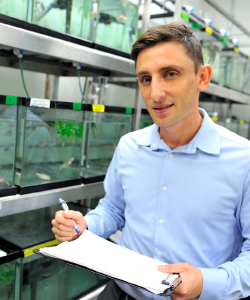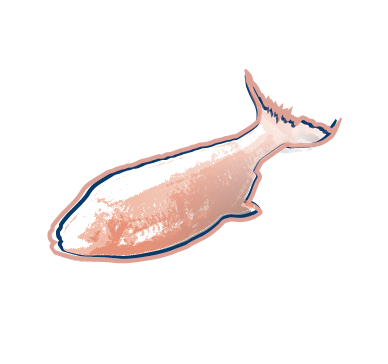Cavefish: Out of the Dark, Into the Limelight
By Wynne Parry
Scientists Suspect These Blind Creatures May Hold Clues to Many Biological Mysteries, Including Human Disease
Living isolated in the dark has altered the Mexican cavefish in eerie ways. Gone are its ancestral dark pigment and disc like eyes, both replaced by pink flesh. However, its unique biology is anything but skin deep, and scientists, including those interested in human health, are taking notice.
Cavefish sleep very little and don’t get stressed. Neither do they swim in coordinated schools like other fish. They also binge eat, put on fat readily and have increased levels of sugar in their blood, the sort that, in a person, might alarm a doctor.

“After their ancestors washed into caves, these fish evolved distinctive traits, a number of which are linked to diseases such as insomnia, obesity and diabetes,” said Alex Keene, Ph.D., an associate professor in the Charles E. Schmidt College of Science.
Keene and his university collaborators, Johanna Kowalko and Erik Duboué, are helping FAU emerge as a hub for the growing field of cavefish research. Together, these young scientists are teasing out the fish’s secrets and establishing it as an unconventional sort of lab rat, a subject for routine use in studies intended to shed light on human biology. “We are developing this fascinating animal into a new experimental model,” Keene said. “For FAU to be at the center of these advances, is exciting.”
Two fish, one species
Scientists believe Mexican cavefish, whose Latin name is Astyanax mexicanus, started out just like the fish that still inhabit the rivers in the Sierra del Abra region of Northeast Mexico. After floods swept Astyanax mexicanus into at least 29 caves, these fish adapted to life in the dark, with little food and no predators. Despite millennia spent apart, cavefish can still breed with river fish — an enormous plus for scientists who can readily examine the effects of cave life by comparing the two.

Scientists first started studying cavefish about a century ago, but within the past decade, interest in them has expanded, according to Kowalko, Ph.D., an assistant professor of biology in the Harriet L. Wilkes Honors College. “The recent development of new genetic and genomic technologies have allowed the field to take many new and exciting directions as new genomic resources, like the cavefish genome, and functional genetic tools have become available for this species,” she said. As a postdoc, Kowalko adapted gene editing systems to make precise changes within cave and river fish genomes. New technologies like this have made it possible to ask all kinds of new questions with these fish, she said. Kowalko is using gene editing to examine their sociability. Unlike more gregarious river fish, cavefish don’t swim in coordinated schools. “We now have the tools to perturb genes we suspect are responsible, to see if that changes schooling behavior,” she said.
Starting points
The subjects of the trio’s experiments inhabit three tank- lined “fish rooms” on the Jupiter campus. Many more are coming. A recent grant from the National Science Foundation is making it possible for the FAU researchers and their collaborators to develop new research tools and to prepare to supply the fish to labs around the world.

Duboué, Ph.D., an assistant professor of biology in the Harriet L. Wilkes Honors College, together with Keene, is working to create one such type of experiment-ready fish: All of the nerves in its brain and spinal cord will be genetically engineered to fluoresce when they fire electrical signals. Even made visible, this activity can still be difficult to interpret. He and Keene are building another resource — detailed, three- dimensional reconstructions of fish brains — that will make it possible to more accurately decode the green glow.
In his own experiments, Duboué has found that river fish placed in an unfamiliar tank will hide out at the bottom, a sign of stress. Cavefish, however, begin exploring upward much more quickly. Duboué thinks this boldness may result from living without fear of being eaten. The stressed-out and stress-resistant fish may ultimately have something to tell us about human anxiety. “We don’t understand why some people handle stress really well and others don’t,” he said. “If we can trace a cavefish’s dampened stress response to its genes or brain anatomy, those may be starting points for human research.”
Secrets to resilience
Likewise, Keene’s work suggests potential insights on sleep disorders. Before he and Duboué arrived at FAU, together they discovered that cavefish doze about 80 percent less than river fish. Keene has continued to tease out this difference, which he thinks might have arisen to allow cavefish to spend more time searching for food.
Researchers elsewhere have uncovered other parallels to familiar conditions. Cavefish eat insatiably, put on more fat than river fish, and often possess a mutation associated with human obesity. Meanwhile, cavefish have higher levels of potentially harmful blood sugar than do river fish. In humans, elevated blood sugar is the primary characteristic of diabetes.
Keene and colleagues from the University of Minnesota and Stowers Institute for Medical Research are following these leads. With funding from the National Institutes of Health, they are examining the genetic underpinnings of sleep, eating and metabolism in these fish. Perhaps most telling is what isn’t happening to cavefish; they seem generally healthy and live about as long as river fish. “If we can figure out what makes them resilient to the harmful effects of, for example, chronic sleep loss,” Keene said, “then we may find new ways to treat these disorders in humans.”

If you would like more information, please contact us at dorcommunications@fau.edu.
